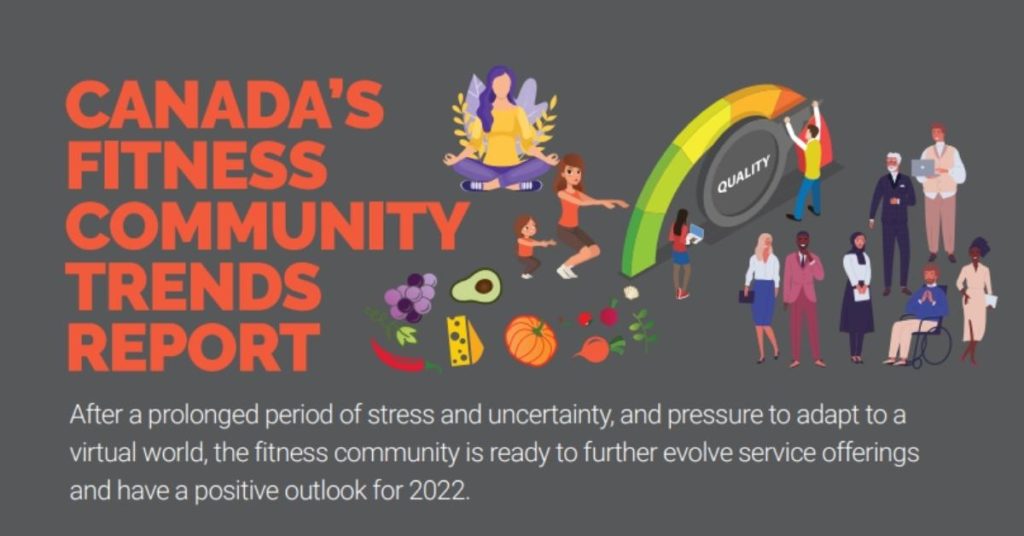canfitpro Fitness Trends survey predicts mind-body fitness for anyone, anywhere
By Maureen ‘Mo’ Hagan, COO canfitpro
(originally posted on GoodLife Fitness)
Increased sedentary time during the pandemic has affected our overall health. Remote work, home-schooling, shelter in place measures and the closure of fitness, recreation and sport facilities and programs are contributing to more sedentary behaviour. We’ve witnessed changes in our children’s physical activity levels and our own, observed the struggles of relatives aggravated by chronic conditions and dealt with personal mental and emotional health issues.
Fitness professionals across Canada have been forced to adapt quickly in order to continue to reach people to keep them active for their health. The past year has seen accelerated changes as digital fitness content became the norm and the fitness community adapted to provide in-person and on-demand content where and when their clients and members want to work out. The fitness industry has gone through a complete shift, and it has made fitness more accessible and flexible for many.
To find out more about new directions for fitness and what people should expect, canfitpro reached out to 54,000+ fitness professionals and 3,500+ fitness business owners from across Canada in November 2021 as part of its annual Fitness Trends survey. In addition to sharing their experiences from the past year as part of a community health check, the fitness community was encouraged to evaluate and vote on predictions likely to impact the industry in the upcoming year.
The results are in! Some of the leading trends fitness professionals expect to see emerge or continue in 2022 include:
- Demand for mind-body fitness offerings – People are already seeking balanced workouts where exercise is paired with restorative care practices. To satisfy this growing consumer segment, Canada will likely begin to see the opening and rapid expansion of fitness facilities that divide their space to offer mind-body experiences – providing smaller class sizes, stretching zones, sleep pods and even meditation rooms. To tap into the health benefits connecting with nature has on the mind and body, it is possible that dedicated outdoor spaces or plant-filled zones will also be integrated into the holistic club experience.
- New programs designed for all generations – Canadian families are looking to adopt more collective approaches to household health and fitness – and are engaging their fitness professional to help with coaching for the whole family. As more people recognize that physical activity is vital for good health, there will be a rise in programs that target specific generational groups, as well as intergenerational fitness for multiple ages. Youth and sports-performance programs are filling as parents, guardians and others seek to help children and youths regain and develop their movement, flexibility, coordination, and balance. Personal trainers and coaches are delivering partner training to grandparents, parents and their kids, siblings, couples and friends. Generational programs are being designed with fitness options tailored to specific abilities and physical/mental needs.
- Leveling up with skills in nutrition coaching – Along with a renewed focus on fitness, Canadians are also building healthier relationships with foods. In fact, 1 in 10 Canadians have tried healthy meal kit service for the first time during the pandemic (source: Stats Canada). With the fitness professional more engaged in the household, it is only natural for expectations to be placed on them with respect to nutritional guidance. Anticipating this interest, fitness professionals are expanding their credentials in healthy eating and weight management to deliver nutritional guidance and a comprehensive approach to whole-body care.
- A move toward quality and smart technology – During the pandemic many fitness lovers invested in at-home gyms, health trackers and wearables, and memberships with on-demand fitness providers to stay on track when gyms were closed. While all this provides convenience to get active no matter what, it isn’t hindering their desire to return to gyms. In fact, it’s influencing their expectations. As people return to gyms and studios, there will be more impetus for facilities to offer connectivity with wearable devices so members can access their on-demand content, align their gym and at-home workouts and capture their health and fitness progress data seamlessly.
Fitness professionals indicated they expect these programs to be in greatest demand for 2022:
- High Intensity Interval Training (54%)
- Bodyweight-based strength and/or functional training (49%)
- Dance, pre-choreographed classes (44%)
- Outdoor conditioning (37%)
- Strength training with equipment (35%)
- Circuit training (31%)
- Functional resistance training (31%)
- Indoor cycling classes (26%)
- Boxing/kickboxing/MMA classes (25%)
- Sports performance conditioning (21%)
Fitness is evolving to be more accessible and to offer more variety and programs for every interest and ability. We look forward to supporting more people we all return to physical activity and better health. To find out more about the canfitpro Fitness Trends survey check out canfitpro.com/trendsreport



